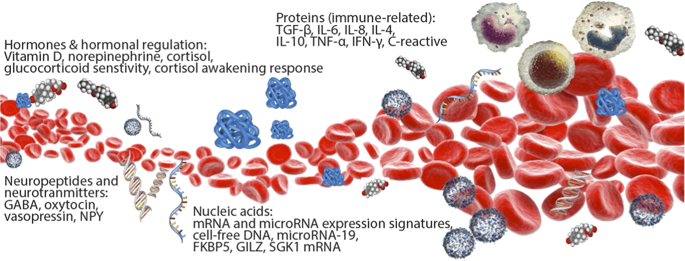当前位置:
X-MOL 学术
›
Mol. Psychiatry
›
论文详情
Our official English website, www.x-mol.net, welcomes your
feedback! (Note: you will need to create a separate account there.)
Literature review and methodological considerations for understanding circulating risk biomarkers following trauma exposure.
Molecular Psychiatry ( IF 9.6 ) Pub Date : 2019-12-20 , DOI: 10.1038/s41380-019-0636-5 Sarah D Linnstaedt 1, 2 , Anthony S Zannas 1, 3, 4 , Samuel A McLean 1, 2, 5 , Karestan C Koenen 6 , Kerry J Ressler 7
Molecular Psychiatry ( IF 9.6 ) Pub Date : 2019-12-20 , DOI: 10.1038/s41380-019-0636-5 Sarah D Linnstaedt 1, 2 , Anthony S Zannas 1, 3, 4 , Samuel A McLean 1, 2, 5 , Karestan C Koenen 6 , Kerry J Ressler 7
Affiliation

|
Exposure to traumatic events is common. While many individuals recover following trauma exposure, a substantial subset develop adverse posttraumatic neuropsychiatric sequelae (APNS) such as posttraumatic stress, major depression, and regional or widespread chronic musculoskeletal pain. APNS cause substantial burden to the individual and to society, causing functional impairment and physical disability, risk for suicide, lost workdays, and increased health care costs. Contemporary treatment is limited by an inability to identify individuals at high risk of APNS in the immediate aftermath of trauma, and an inability to identify optimal treatments for individual patients. Our purpose is to provide a comprehensive review describing candidate blood-based biomarkers that may help to identify those at high risk of APNS and/or guide individual intervention decision-making. Such blood-based biomarkers include circulating biological factors such as hormones, proteins, immune molecules, neuropeptides, neurotransmitters, mRNA, and noncoding RNA expression signatures, while we do not review genetic and epigenetic biomarkers due to other recent reviews of this topic. The current state of the literature on circulating risk biomarkers of APNS is summarized, and key considerations and challenges for their discovery and translation are discussed. We also describe the AURORA study, a specific example of current scientific efforts to identify such circulating risk biomarkers and the largest study to date focused on identifying risk and prognostic factors in the aftermath of trauma exposure.
中文翻译:

了解创伤暴露后循环风险生物标志物的文献综述和方法学考虑。
遭受创伤性事件是很常见的。虽然许多人在经历创伤后可以康复,但相当一部分人会出现不良的创伤后神经精神后遗症 (APNS),例如创伤后应激、重性抑郁和局部或广泛的慢性肌肉骨骼疼痛。 APNS 给个人和社会造成沉重负担,导致功能障碍和身体残疾、自杀风险、工作日损失以及医疗费用增加。当前的治疗方法受到限制,因为无法在创伤后立即识别出 APNS 高风险个体,也无法为个体患者确定最佳治疗方法。我们的目的是提供一个全面的综述,描述候选的血液生物标志物,这可能有助于识别 APNS 高风险人群和/或指导个人干预决策。此类血液生物标志物包括循环生物因子,如激素、蛋白质、免疫分子、神经肽、神经递质、mRNA 和非编码 RNA 表达特征,而由于该主题的其他最新评论,我们不审查遗传和表观遗传生物标志物。总结了有关 APNS 循环风险生物标志物的文献现状,并讨论了其发现和转化的关键考虑因素和挑战。我们还描述了 AURORA 研究,这是当前识别此类循环风险生物标志物的科学努力的一个具体例子,也是迄今为止最大的研究,重点是识别创伤暴露后的风险和预后因素。
更新日期:2019-12-20
中文翻译:

了解创伤暴露后循环风险生物标志物的文献综述和方法学考虑。
遭受创伤性事件是很常见的。虽然许多人在经历创伤后可以康复,但相当一部分人会出现不良的创伤后神经精神后遗症 (APNS),例如创伤后应激、重性抑郁和局部或广泛的慢性肌肉骨骼疼痛。 APNS 给个人和社会造成沉重负担,导致功能障碍和身体残疾、自杀风险、工作日损失以及医疗费用增加。当前的治疗方法受到限制,因为无法在创伤后立即识别出 APNS 高风险个体,也无法为个体患者确定最佳治疗方法。我们的目的是提供一个全面的综述,描述候选的血液生物标志物,这可能有助于识别 APNS 高风险人群和/或指导个人干预决策。此类血液生物标志物包括循环生物因子,如激素、蛋白质、免疫分子、神经肽、神经递质、mRNA 和非编码 RNA 表达特征,而由于该主题的其他最新评论,我们不审查遗传和表观遗传生物标志物。总结了有关 APNS 循环风险生物标志物的文献现状,并讨论了其发现和转化的关键考虑因素和挑战。我们还描述了 AURORA 研究,这是当前识别此类循环风险生物标志物的科学努力的一个具体例子,也是迄今为止最大的研究,重点是识别创伤暴露后的风险和预后因素。











































 京公网安备 11010802027423号
京公网安备 11010802027423号